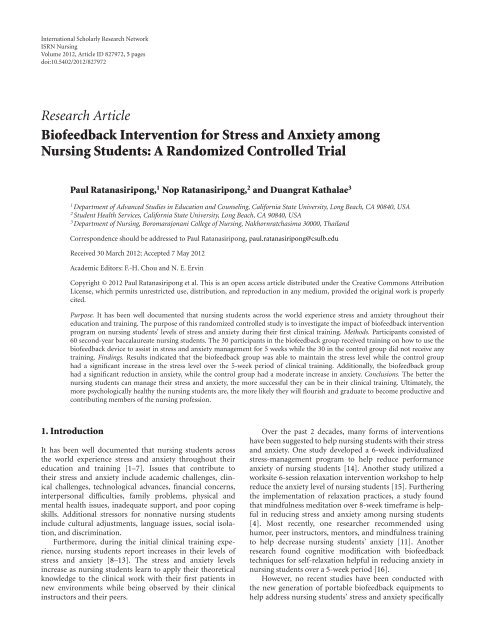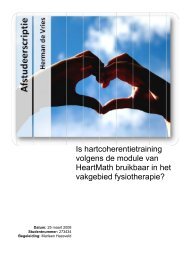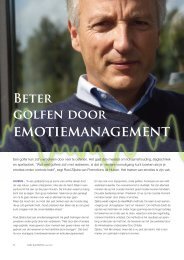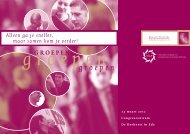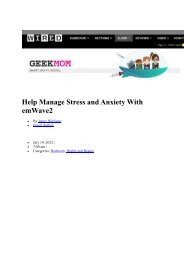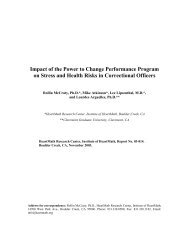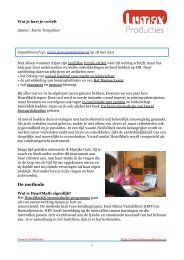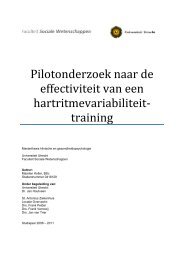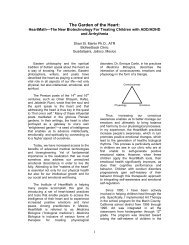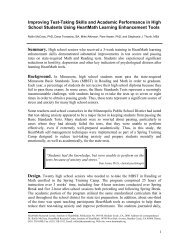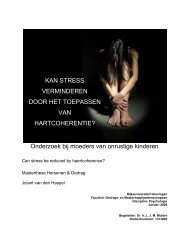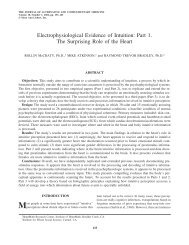Research Article Biofeedback Intervention for Stress and Anxiety ...
Research Article Biofeedback Intervention for Stress and Anxiety ...
Research Article Biofeedback Intervention for Stress and Anxiety ...
You also want an ePaper? Increase the reach of your titles
YUMPU automatically turns print PDFs into web optimized ePapers that Google loves.
International Scholarly <strong>Research</strong> NetworkISRN NursingVolume 2012, <strong>Article</strong> ID 827972, 5 pagesdoi:10.5402/2012/827972<strong>Research</strong> <strong>Article</strong><strong>Biofeedback</strong> <strong>Intervention</strong> <strong>for</strong> <strong>Stress</strong> <strong>and</strong> <strong>Anxiety</strong> amongNursing Students: A R<strong>and</strong>omized Controlled TrialPaul Ratanasiripong, 1 Nop Ratanasiripong, 2 <strong>and</strong> Duangrat Kathalae 31Department of Advanced Studies in Education <strong>and</strong> Counseling, Cali<strong>for</strong>nia State University, Long Beach, CA 90840, USA2Student Health Services, Cali<strong>for</strong>nia State University, Long Beach, CA 90840, USA3Department of Nursing, Boromarajonani College of Nursing, Nakhornratchasima 30000, Thail<strong>and</strong>Correspondence should be addressed to Paul Ratanasiripong, paul.ratanasiripong@csulb.eduReceived 30 March 2012; Accepted 7 May 2012Academic Editors: F.-H. Chou <strong>and</strong> N. E. ErvinCopyright © 2012 Paul Ratanasiripong et al. This is an open access article distributed under the Creative Commons AttributionLicense, which permits unrestricted use, distribution, <strong>and</strong> reproduction in any medium, provided the original work is properlycited.Purpose. It has been well documented that nursing students across the world experience stress <strong>and</strong> anxiety throughout theireducation <strong>and</strong> training. The purpose of this r<strong>and</strong>omized controlled study is to investigate the impact of biofeedback interventionprogram on nursing students’ levels of stress <strong>and</strong> anxiety during their first clinical training. Methods. Participants consisted of60 second-year baccalaureate nursing students. The 30 participants in the biofeedback group received training on how to use thebiofeedback device to assist in stress <strong>and</strong> anxiety management <strong>for</strong> 5 weeks while the 30 in the control group did not receive anytraining. Findings. Results indicated that the biofeedback group was able to maintain the stress level while the control grouphad a significant increase in the stress level over the 5-week period of clinical training. Additionally, the biofeedback grouphad a significant reduction in anxiety, while the control group had a moderate increase in anxiety. Conclusions. The better thenursing students can manage their stress <strong>and</strong> anxiety, the more successful they can be in their clinical training. Ultimately, themore psychologically healthy the nursing students are, the more likely they will flourish <strong>and</strong> graduate to become productive <strong>and</strong>contributing members of the nursing profession.1. IntroductionIt has been well documented that nursing students acrossthe world experience stress <strong>and</strong> anxiety throughout theireducation <strong>and</strong> training [1–7]. Issues that contribute totheir stress <strong>and</strong> anxiety include academic challenges, clinicalchallenges, technological advances, financial concerns,interpersonal difficulties, family problems, physical <strong>and</strong>mental health issues, inadequate support, <strong>and</strong> poor copingskills. Additional stressors <strong>for</strong> nonnative nursing studentsinclude cultural adjustments, language issues, social isolation,<strong>and</strong> discrimination.Furthermore, during the initial clinical training experience,nursing students report increases in their levels ofstress <strong>and</strong> anxiety [8–13]. The stress <strong>and</strong> anxiety levelsincrease as nursing students learn to apply their theoreticalknowledge to the clinical work with their first patients innew environments while being observed by their clinicalinstructors <strong>and</strong> their peers.Over the past 2 decades, many <strong>for</strong>ms of interventionshave been suggested to help nursing students with their stress<strong>and</strong> anxiety. One study developed a 6-week individualizedstress-management program to help reduce per<strong>for</strong>manceanxiety of nursing students [14]. Another study utilized aworksite 6-session relaxation intervention workshop to helpreduce the anxiety level of nursing students [15]. Furtheringthe implementation of relaxation practices, a study foundthat mindfulness meditation over 8-week timeframe is helpfulin reducing stress <strong>and</strong> anxiety among nursing students[4]. Most recently, one researcher recommended usinghumor, peer instructors, mentors, <strong>and</strong> mindfulness trainingto help decrease nursing students’ anxiety [11]. Anotherresearch found cognitive modification with biofeedbacktechniques <strong>for</strong> self-relaxation helpful in reducing anxiety innursing students over a 5-week period [16].However, no recent studies have been conducted withthe new generation of portable biofeedback equipments tohelp address nursing students’ stress <strong>and</strong> anxiety specifically
ISRN Nursing 3either the biofeedback intervention group or the controlgroup. All participants completed the pre-intervention <strong>and</strong>post-intervention surveys consisting of brief demographicin<strong>for</strong>mation, Perceived <strong>Stress</strong> Scale, <strong>and</strong> State <strong>Anxiety</strong> Scale.The preintervention survey was completed at the beginningof the new school year, be<strong>for</strong>e classes <strong>and</strong> clinical trainingbegan. The post-intervention survey was conducted 5 weeksafter the pre-intervention survey. An incentive of 150 Baht(local currency equivalent to 5 moderate meals) was given toeach participant who volunteered <strong>for</strong> the study.After completing the preintervention survey, the 30participants in the biofeedback group received 2 trainingsessions led by the researchers on how to use the portablebiofeedback device to assist in stress <strong>and</strong> anxiety management.Specifically, participants were trained to controlthe HRV through slower breathing <strong>and</strong> positive emotions.The portable biofeedback device provided immediate visual<strong>and</strong> auditory feedback to the participants to help themlearn to control the HRV. After completing the training<strong>and</strong> being able to achieve a sustained heart-rhythm patternassociated with lower stress <strong>and</strong> anxiety-related symptoms,each nursing student in the biofeedback group was given aportable biofeedback device to use <strong>for</strong> 5 weeks. They wereinstructed to use the portable device <strong>for</strong> biofeedback training3 times per day <strong>and</strong> record their practice time on the log.The 30 participants in the control group did not receive anytraining or device to use.The Perceived <strong>Stress</strong> Scale (PSS) was used to assessparticipants’ level of perceived stress in the past month[32]. The PSS contains 10 items using a 5-point Likert scale(0 = never, 4 = very often). A higher score indicates a higherlevel of perceived stress. Several previous studies have usedthe PSS with nursing students [19, 33, 34]. The internalconsistency (Cronbach’s alpha) of the Perceived <strong>Stress</strong> Scale<strong>for</strong> the current sample was .77 <strong>for</strong> the preintervention<strong>and</strong> .80 <strong>for</strong> the postintervention.The State <strong>Anxiety</strong> Scale from the State-Trait <strong>Anxiety</strong>Inventory was used to assess participants’ current level ofanxiety [18]. The State <strong>Anxiety</strong> Scale contains 20 items usinga 4-point Likert scale (0 = not at all, 3 = very much so).A higher score indicates a higher level of current anxiety.Several previous studies have use the State <strong>Anxiety</strong> Scalewith nursing students [6, 15, 35]. The internal consistency(Cronbach’s alpha) of the State <strong>Anxiety</strong> Scale <strong>for</strong> the currentsample was .93 <strong>for</strong> the preintervention <strong>and</strong> .91 <strong>for</strong> the postintervention.4. ResultsNo significant differences in age <strong>and</strong> GPA were foundbetween the biofeedback group <strong>and</strong> the control group (seeTable 1). There were no significant differences in the preinterventionPerceived <strong>Stress</strong> Scale <strong>and</strong> the preinterventionState <strong>Anxiety</strong> Scale between the two groups.4.1. <strong>Stress</strong>. In terms of stress, the biofeedback group had avery small <strong>and</strong> nonsignificant increase in the Perceived <strong>Stress</strong>Scale score over the 5-week period, while the control groupTable 1: Demographics <strong>and</strong> pretest scores <strong>for</strong> biofeedback group<strong>and</strong> control group.Variable<strong>Biofeedback</strong> group (n = 30) Control group (n = 30) PM SD M SDAge 19.30 0.70 19.23 0.50 nsGPA 3.46 0.20 3.45 0.25 ns<strong>Stress</strong> 13.47 4.26 13.27 4.32 ns<strong>Anxiety</strong> 18.60 10.25 16.40 8.34 nsns:notsignificant.had a significant increase (see Figure 1). For the biofeedbackgroup, the mean postintervention PSS score (M = 13.77,SD = 4.64) only slightly increased from the mean preinterventionPSS score (M = 13.47, SD = 4.26). For thecontrol group, the mean postintervention PSS score (M =15.97, SD = 4.37) significantly increased from the meanpreintervention PSS score (M = 13.27, SD = 4.32). A pairedsamplet-test <strong>for</strong> the control group indicated a significantincrease in the PSS score: t(29) = 3.74, p
4 ISRN Nursing2015105013.47 13.77<strong>Biofeedback</strong> groupPreintervention scorePostintervention score13.2715.97Control groupFigure 1: Pre- <strong>and</strong> postintervention mean scores <strong>for</strong> Perceived<strong>Stress</strong> Scale.2015105018.613.7<strong>Biofeedback</strong> groupPreintervention scorePostintervention score16.419.0Control groupFigure 2: Pre- <strong>and</strong> postintervention mean scores <strong>for</strong> State <strong>Anxiety</strong>Scale.<strong>Biofeedback</strong> Group had a significant decrease in their anxietylevel over this 5-week period while those in the control grouphad a moderate increase in anxiety level.5.1. Implications. It is very important <strong>for</strong> nurse educatorsto help nursing students manage their stress <strong>and</strong> anxiety inorder to prevent additional problems. Ross et al. [36] foundthat nursing students who experience high stress tend tobe depressed. High stress <strong>and</strong> anxiety in nursing studentsalso negatively affect learning <strong>and</strong> academic per<strong>for</strong>manceby impeding memory, concentration, <strong>and</strong> problem solvingskills [37]. Depression in nursing students often affects theirability to per<strong>for</strong>m their clinical duties, their relationshipwith the patients, <strong>and</strong> their attitude toward the nursingprofession. Likewise, if nursing students experience problemswith concentration <strong>and</strong> problem solving, not only will theyhave a hard time getting through school, but also will theynot be per<strong>for</strong>ming their nursing duties at optimum levels,which will affect the quality of patient care.The positive results of the biofeedback training programfrom this study give nurse educators another tool to help augmentthe clinical training component of nursing education.With limited investment in time <strong>and</strong> financial resources,a biofeedback training program could be set up to helpimprove the psychological well-being of nursing studentsas they begin their clinical training. Furthermore, nursingstudents will gain awareness of how the body works <strong>and</strong> howthe body <strong>and</strong> mind are linked, ultimately providing themwith a more comprehensive, participatory underst<strong>and</strong>ing oftheir patients.In addition to using biofeedback training to help reduceanxiety, Suliman <strong>and</strong> Halabi [6] also found that criticalthinking <strong>and</strong> self-esteem were negatively related to stateanxiety. Nurse educators can train students in criticalthinking skills as well as set up programs to help improvestudents’ self-esteem to reduce the anxiety levels amongnursing students. With an increased sense of self-efficacy viabiofeedback training or critical thinking skills along with themastery of each subject or clinical area through education<strong>and</strong> training, nursing students can keep stress <strong>and</strong> anxiety atbay <strong>and</strong> per<strong>for</strong>m according to their potential.5.2. Limitations <strong>and</strong> Future <strong>Research</strong>. This study was conductedonly at one nursing college in one country. Futurestudies should consider replicating the study at multiplenursing colleges <strong>and</strong> multiple countries. Additionally, afollow-up study on the impact of the biofeedback trainingon stress, anxiety, <strong>and</strong> academic per<strong>for</strong>mance of nursingstudents after one to two years will help nurse educators tobetter underst<strong>and</strong> the long-term efficacy of the biofeedbackintervention program.6. ConclusionWith clinical training being one of the most vital componentsof the nursing education, it is imperative that nurse educatorscontinue the ef<strong>for</strong>t to help nursing students manage theirstress <strong>and</strong> anxiety during this important process. <strong>Biofeedback</strong>training is one tool that has been demonstrated to beeffective in helping with this developmental journey. Thebetter the nursing students can manage their stress <strong>and</strong>anxiety, the more successful they can be in their clinicaltraining. Ultimately, the more psychologically healthy thenursing students are, the more likely they will flourish <strong>and</strong>graduate to become productive <strong>and</strong> contributing membersof the nursing profession.References[1] D. L. Beck <strong>and</strong> R. Srivastava, “Perceived level <strong>and</strong> sources ofstress in baccalaureate nursing students,” Journal of NursingEducation,vol.30,no.3,pp.127–133,1991.[2] L. J. Cook, “Inviting teaching behaviors of clinical faculty <strong>and</strong>nursing students’ anxiety,” Journal of Nursing Education, vol.44, no. 4, pp. 156–161, 2005.[3] D. L. Junious, A. Malecha, K. Tart, <strong>and</strong> A. Young, “<strong>Stress</strong> <strong>and</strong>perceived faculty support among <strong>for</strong>eign-born baccalaureatenursing students,” Journal of Nursing Education, vol. 49, no. 5,pp. 261–270, 2010.[4] Y. S. Kang, S. Y. Choi, <strong>and</strong> E. Ryu, “The effectiveness of astress coping program based on mindfulness meditation on
ISRN Nursing 5the stress, anxiety, <strong>and</strong> depression experienced by nursingstudents in Korea,” Nurse Education Today, vol. 29, no. 5, pp.538–543, 2009.[5] P. Ratanasiripong <strong>and</strong> C. C. D. C. Wang, “Psychological wellbeingof Thai nursing students,” Nurse Education Today, vol.31, no. 4, pp. 412–416, 2011.[6] W. A. Suliman <strong>and</strong> J. Halabi, “Critical thinking, self-esteem,<strong>and</strong> state anxiety of nursing students,” Nurse Education Today,vol. 27, no. 2, pp. 162–168, 2007.[7] A. Tully, “<strong>Stress</strong>, sources of stress <strong>and</strong> ways of coping amongpsychiatric nursing students,” Journal of Psychiatric <strong>and</strong> MentalHealth Nursing,vol.11,no.1,pp.43–47,2004.[8] H. Admi, “Nursing Students’ <strong>Stress</strong> during the Initial ClinicalExperience,” Journal of Nursing Education, vol. 36, no. 7, pp.323–327, 1997.[9] C. K. L. Chan, W. K. W. So, <strong>and</strong> D. Y. T. Fong, “HongKong baccalaureate nursing students’ stress <strong>and</strong> their copingstrategies in clinical practice,” Journal of Professional Nursing,vol. 25, no. 5, pp. 307–313, 2009.[10] G. Mahat, “<strong>Stress</strong> <strong>and</strong> coping: junior baccalaureate nursingstudents in clinical settings,” Nursing Forum, vol. 33, no. 1, pp.11–19, 1998.[11] L. M. Moscaritolo, “<strong>Intervention</strong>al strategies to decreasenursing student anxiety in the clinical learning environment,”Journal of Nursing Education,vol.48,no.1,pp.17–23,2009.[12] F. Sharif <strong>and</strong> S. Masoumi, “A qualitative study of nursingstudent experiences of clinical practice,” BMC Nursing, vol.4,<strong>Article</strong> 6, 2005.[13] X. Zupiria Gorostidi, X. Huitzi Egilegor, M. Jose Alberdi Ericeet al., “<strong>Stress</strong> sources in nursing practice. Evolution duringnursing training,” Nurse Education Today, vol. 27, no. 7, pp.777–787, 2007.[14] K. L. Godbey <strong>and</strong> M. M. Courage, “<strong>Stress</strong>-management program:intervention in nursing student per<strong>for</strong>mance anxiety,”Archives of Psychiatric Nursing,vol.8,no.3,pp.190–199,1994.[15] M. C. Jones <strong>and</strong> D. W. Johnston, “Evaluating the impact of aworksite stress management programme <strong>for</strong> distressed studentnurses: a r<strong>and</strong>omised controlled trial,” Psychology <strong>and</strong> Health,vol. 15, no. 5, pp. 689–706, 2000.[16] D. Heaman, “The quieting response (QR): a modality <strong>for</strong>reduction of psychophysiologic stress in nursing students,”Journal of Nursing Education,vol.34,no.1,pp.5–10,1995.[17] American Institute of <strong>Stress</strong>, Definition of <strong>Stress</strong>, 2012,http://www.stress.org/Definition of stress.htm.[18] C. D. Spielberger, Manual <strong>for</strong> the State-Trait <strong>Anxiety</strong> Inventory(Form Y), Consulting Psychologists Press, Palo Alto, Calif,USA, 1983.[19] C. Mimura, T. Murrells, <strong>and</strong> P. Griffiths, “The associationbetween stress, self-esteem <strong>and</strong> childhood acceptance innursing <strong>and</strong> pharmacy students: a comparative cross-culturalanalysis,” <strong>Stress</strong> <strong>and</strong> Health,vol.25,no.3,pp.209–220,2009.[20] C. B. Yucha, S. Kowalski, <strong>and</strong> C. Cross, “Student stress <strong>and</strong>academic per<strong>for</strong>mance: home hospital program,” Journal ofNursing Education,vol.48,no.11,pp.631–637,2009.[21] K. Melo, Clinical Practice <strong>Anxiety</strong> among Third Year BaccalaureateNursing Students in CBL <strong>and</strong> Those in TraditionalCurricula,ProQuestDissertations&ThesesDatabase,2008.[22] C. Jimenez, P. M. Navia-Osorio, <strong>and</strong> C. V. Diaz, “<strong>Stress</strong> <strong>and</strong>health in novice <strong>and</strong> experienced nursing students,” Journal ofAdvanced Nursing,vol.66,no.2,pp.442–455,2010.[23] S. P. Shipton, “The process of seeking stress-care: copingas experienced by senior baccalaureate nursing students inresponse to appraised clinical stress,” Journal of NursingEducation,vol.41,no.6,pp.243–256,2002.[24] <strong>Biofeedback</strong> Certification International Alliance, Overview of<strong>Biofeedback</strong>, 2012, http://www.bcia.org/i4a/pages/index.cfm?pageid=3524.[25] C. Yucha <strong>and</strong> D. Montgomery, Evidenced-Based Practicein <strong>Biofeedback</strong> <strong>and</strong> Neurofeedback, Association<strong>for</strong>AppliedPsychophysiology <strong>and</strong> <strong>Biofeedback</strong>, Wheat Ridge, Colo, USA,2008.[26] A. Leboeuf, “The effects of EMG feedback training onstate anxiety in introverts <strong>and</strong> extraverts,” Journal of ClinicalPsychology,vol.33,no.1,pp.251–253,1977.[27] Y. Ohkuma, “Effects of evoking imagery on the control ofperipheral skin temperature,” Japanese Journal of Psychology,vol. 54, no. 2, pp. 88–94, 1983.[28] S. W. Utz, “The effect of instructions on cognitive strategies<strong>and</strong> per<strong>for</strong>mance in biofeedback,” Journal of BehavioralMedicine,vol.17,no.3,pp.291–308,1994.[29] C. A. Prato, <strong>Biofeedback</strong> Assisted Relaxation Training Programto Decrease Test <strong>Anxiety</strong> in Nursing Students, ProQuest Dissertations& Theses Database, 2009.[30] P. Ratanasiripong, K. Sverduk, D. Hayashino, <strong>and</strong> J. Prince,“Setting up the next generation biofeedback program <strong>for</strong> stress<strong>and</strong> anxiety management <strong>for</strong> college students: a simple <strong>and</strong>cost-effective approach,” College Student Journal, vol.44,pp.97–100, 2010.[31] E. Erdfelder, F. Faul, A. Buchner, <strong>and</strong> A. G. Lang, “Statisticalpower analyses using G ∗ Power 3.1: tests <strong>for</strong> correlation <strong>and</strong>regression analyses,” Behavior <strong>Research</strong> Methods, vol. 41, no. 4,pp. 1149–1160, 2009.[32] S. Cohen, T. Kamarck, <strong>and</strong> R. Mermelstein, “A global measureof perceived stress,” Journal of Health <strong>and</strong> Social Behavior,vol.24, no. 4, pp. 385–396, 1983.[33] Y. Birks, J. McKendree, <strong>and</strong> I. Watt, “Emotional intelligence<strong>and</strong> perceived stress in healthcare students: a multiinstitutional,multi-professional survey,” BMC Medical Education,vol.9,no.1,article61,2009.[34] J. E. R. Reilly <strong>and</strong> J. J. Fitzpatrick, “Perceived stress <strong>and</strong> senseof belonging in doctor of nursing practice students,” Journal ofProfessional Nursing,vol.25,no.2,pp.81–86,2009.[35] N. Kanji, A. White, <strong>and</strong> E. Ernst, “Autogenic training to reduceanxiety in nursing students: r<strong>and</strong>omized controlled trial,”Journal of Advanced Nursing,vol.53,no.6,pp.729–735,2006.[36] R. Ross, R. Zeller, P. Srisaeng, S. Yimmee, S. Somchid, <strong>and</strong> W.Sawatphanit, “Depression, stress, emotional support, <strong>and</strong> selfesteemamong baccalaureate nursing students in Thail<strong>and</strong>,”International Journal of Nursing Education Scholarship, vol.2,<strong>Article</strong> 25, 2005.[37] A. E. Beddoe <strong>and</strong> S. O. Murphy, “Does mindfulness decreasestress <strong>and</strong> foster empathy among nursing students?” Journal ofNursing Education,vol.43,no.7,pp.305–312,2004.


